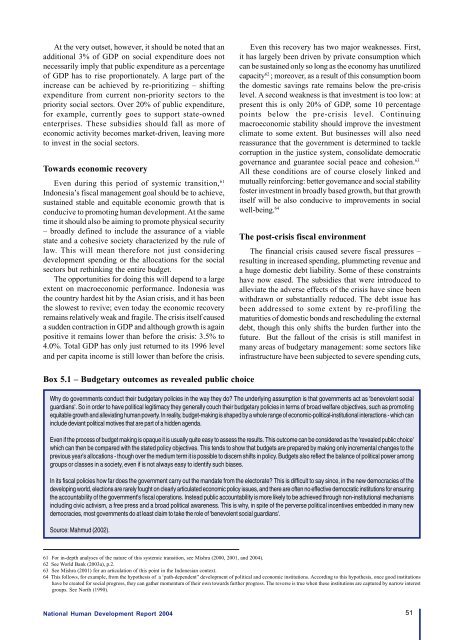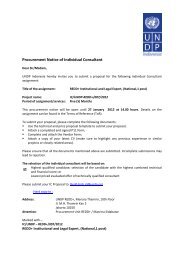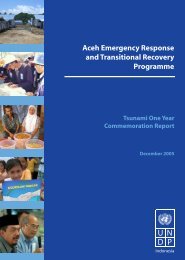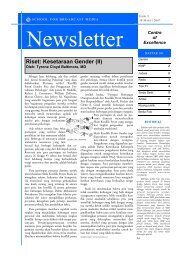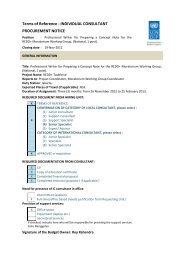Download the Indonesia Human Development Report 2004. - UNDP
Download the Indonesia Human Development Report 2004. - UNDP
Download the Indonesia Human Development Report 2004. - UNDP
Create successful ePaper yourself
Turn your PDF publications into a flip-book with our unique Google optimized e-Paper software.
At <strong>the</strong> very outset, however, it should be noted that anadditional 3% of GDP on social expenditure does notnecessarily imply that public expenditure as a percentageof GDP has to rise proportionately. A large part of <strong>the</strong>increase can be achieved by re-prioritizing – shiftingexpenditure from current non-priority sectors to <strong>the</strong>priority social sectors. Over 20% of public expenditure,for example, currently goes to support state-ownedenterprises. These subsidies should fall as more ofeconomic activity becomes market-driven, leaving moreto invest in <strong>the</strong> social sectors.Towards economic recoveryEven during this period of systemic transition, 61<strong>Indonesia</strong>’s fiscal management goal should be to achieve,sustained stable and equitable economic growth that isconducive to promoting human development. At <strong>the</strong> sametime it should also be aiming to promote physical security– broadly defined to include <strong>the</strong> assurance of a viablestate and a cohesive society characterized by <strong>the</strong> rule oflaw. This will mean <strong>the</strong>refore not just consideringdevelopment spending or <strong>the</strong> allocations for <strong>the</strong> socialsectors but rethinking <strong>the</strong> entire budget.The opportunities for doing this will depend to a largeextent on macroeconomic performance. <strong>Indonesia</strong> was<strong>the</strong> country hardest hit by <strong>the</strong> Asian crisis, and it has been<strong>the</strong> slowest to revive; even today <strong>the</strong> economic recoveryremains relatively weak and fragile. The crisis itself causeda sudden contraction in GDP and although growth is againpositive it remains lower than before <strong>the</strong> crisis: 3.5% to4.0%. Total GDP has only just returned to its 1996 leveland per capita income is still lower than before <strong>the</strong> crisis.Even this recovery has two major weaknesses. First,it has largely been driven by private consumption whichcan be sustained only so long as <strong>the</strong> economy has unutilizedcapacity 62 ; moreover, as a result of this consumption boom<strong>the</strong> domestic savings rate remains below <strong>the</strong> pre-crisislevel. A second weakness is that investment is too low: atpresent this is only 20% of GDP, some 10 percentagepoints below <strong>the</strong> pre-crisis level. Continuingmacroeconomic stability should improve <strong>the</strong> investmentclimate to some extent. But businesses will also needreassurance that <strong>the</strong> government is determined to tacklecorruption in <strong>the</strong> justice system, consolidate democraticgovernance and guarantee social peace and cohesion. 63All <strong>the</strong>se conditions are of course closely linked andmutually reinforcing: better governance and social stabilityfoster investment in broadly based growth, but that growthitself will be also conducive to improvements in socialwell-being. 64The post-crisis fiscal environmentThe financial crisis caused severe fiscal pressures –resulting in increased spending, plummeting revenue anda huge domestic debt liability. Some of <strong>the</strong>se constraintshave now eased. The subsidies that were introduced toalleviate <strong>the</strong> adverse effects of <strong>the</strong> crisis have since beenwithdrawn or substantially reduced. The debt issue hasbeen addressed to some extent by re-profiling <strong>the</strong>maturities of domestic bonds and rescheduling <strong>the</strong> externaldebt, though this only shifts <strong>the</strong> burden fur<strong>the</strong>r into <strong>the</strong>future. But <strong>the</strong> fallout of <strong>the</strong> crisis is still manifest inmany areas of budgetary management: some sectors likeinfrastructure have been subjected to severe spending cuts,Box 5.1 – Budgetary outcomes as revealed public choiceWhy do governments conduct <strong>the</strong>ir budgetary policies in <strong>the</strong> way <strong>the</strong>y do? The underlying assumption is that governments act as 'benevolent socialguardians'. So in order to have political legitimacy <strong>the</strong>y generally couch <strong>the</strong>ir budgetary policies in terms of broad welfare objectives, such as promotingequitable growth and alleviating human poverty. In reality, budget-making is shaped by a whole range of economic-political-institutional interactions - which caninclude deviant political motives that are part of a hidden agenda.Even if <strong>the</strong> process of budget making is opaque it is usually quite easy to assess <strong>the</strong> results. This outcome can be considered as <strong>the</strong> 'revealed public choice'which can <strong>the</strong>n be compared with <strong>the</strong> stated policy objectives. This tends to show that budgets are prepared by making only incremental changes to <strong>the</strong>previous year's allocations - though over <strong>the</strong> medium term it is possible to discern shifts in policy. Budgets also reflect <strong>the</strong> balance of political power amonggroups or classes in a society, even if is not always easy to identify such biases.In its fiscal policies how far does <strong>the</strong> government carry out <strong>the</strong> mandate from <strong>the</strong> electorate? This is difficult to say since, in <strong>the</strong> new democracies of <strong>the</strong>developing world, elections are rarely fought on clearly articulated economic policy issues, and <strong>the</strong>re are often no effective democratic institutions for ensuring<strong>the</strong> accountability of <strong>the</strong> government's fiscal operations. Instead public accountability is more likely to be achieved through non-institutional mechanismsincluding civic activism, a free press and a broad political awareness. This is why, in spite of <strong>the</strong> perverse political incentives embedded in many newdemocracies, most governments do at least claim to take <strong>the</strong> role of 'benevolent social guardians'.Source: Mahmud (2002).61 For in-depth analyses of <strong>the</strong> nature of this systemic transition, see Mishra (2000, 2001, and 2004).62 See World Bank (2003a), p.2.63 See Mishra (2001) for an articulation of this point in <strong>the</strong> <strong>Indonesia</strong>n context.64 This follows, for example, from <strong>the</strong> hypo<strong>the</strong>sis of a ‘path-dependent” development of political and economic institutions. According to this hypo<strong>the</strong>sis, once good institutionshave be created for social progress, <strong>the</strong>y can ga<strong>the</strong>r momentum of <strong>the</strong>ir own towards fur<strong>the</strong>r progress. The reverse is true when <strong>the</strong>se institutions are captured by narrow interestgroups. See North (1990).National <strong>Human</strong> <strong>Development</strong> <strong>Report</strong> 2004 51


